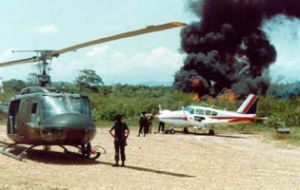MercoPress. South Atlantic News Agency
Bolivia “shifts strategy” and attacks coca growing stronghold
 Coca eradication in Bolivia
Coca eradication in Bolivia Bolivia opened a new front this week in its fight to reduce illegal coca production, sending United States backed eradication teams into a traditional coca-growing region in the Andean foothills long avoided by previous governments.
But Bolivian officials described the program more as a shift in strategy to confront the country's fastest growing coca-producing area than an effort to increase total coca eradication. President Evo Morales, a former coca farmer, has said he is concerned about the increasing coca crop in the Yungas, a stretch of steep green Andean foothills northeast of the capital La Paz. The Yungas is Bolivia's oldest coca growing region and produces most of the small green leaves chewed by Bolivians for millennia as a mild stimulant and treatment for altitude sickness. But an unknown portion of its crop also is converted into cocaine, mostly for shipment to Brazil and Europe. In recent decades, the Yungas crop has expanded to an estimated 45,700 acres, well beyond the 30,000 acres protected by a 1988 Bolivian law. Past eradication strategies largely ignored the larger Yungas crop to focus on the Chapare coca region, near the central city of Cochabamba. Contrary to previous administrations President Morales has said he's not against coca plantations but rather against the manufacturing of cocaine and other drugs and has requested United States also plays a role by cutting demand. Last year, Bolivian cooperative eradication programs paid for by the U.S. destroyed some 12,350 acres of coca, nearly all in Chapare. United Nations estimated Bolivia's 2005 coca crop at 62,700 acres, making it the world's third largest producer behind Colombia and Peru.




Top Comments
Disclaimer & comment rulesCommenting for this story is now closed.
If you have a Facebook account, become a fan and comment on our Facebook Page!